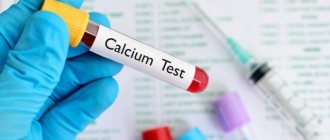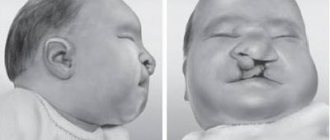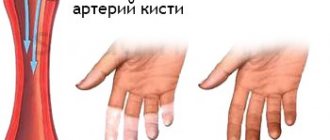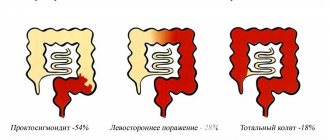Dyspepsia
(
dyspepsia
; Greek dys- + pepsis digestion) is a disease of the gastrointestinal tract of functional origin in children. Dyspepsia occurs as a result of a discrepancy between the demands placed on the body in the form of volume or composition of food and the ability to digest this food with the normal amount of appropriate enzymes of the digestive tract. There is ch. arr. in children up to 8-9 months.
The term "dyspepsia" was introduced at the end of the 19th century. Viennese pediatrician H. Widerhofer to designate a disease of young children with clinical manifestations in the form of vomiting and diarrhea, not accompanied by pathomorphological changes. Thus, the purely functional nature of Dyspepsia was emphasized. In the clinic of internal diseases of adults, the term “dyspepsia” is not used; this concept is identical to various gastrointestinal tracts. disorders that occur in a number of diseases. In pediatrics, it is used to designate individual clinical forms.
The main forms of Dyspepsia are: 1) simple; 2) toxic; 3) parenteral.
In the first days of a newborn’s life, physiological, or transitional, dyspepsia is often observed.
Its occurrence is based on the process of adaptation of the child’s body to new nutritional conditions and the still unestablished secretory-motor function of the gastrointestinal tract. tract. The increased sensitivity of some children to the fat of human milk, as well as lactose intolerance, due to a decrease in the activity of lactase in the child’s intestinal mucosa, is important. The role of physiological changes in the bacterial flora of the newborn’s intestine cannot be excluded: at birth, the sterile intestine is populated by various bacteria from the environment. With the transition to breastfeeding, this flora is replaced by Bact. bifidus. When bacteria die, a certain amount of toxins are released that contribute to the development of phenomena D. Klin, manifestations of physiol. D. scanty - frequent, liquid greenish squirting stools, bloating, some restlessness, mild diaper rash on the buttocks. No special treatment is required; when lactation is established (see), these symptoms disappear.
How does dyspepsia manifest?
Dyspeptic symptoms are signs of damage to the digestive canal. The most significant include:
- attacks of nausea;
- the occurrence of episodes of vomiting;
- an unpleasant sensation behind the sternum (in the area of the esophagus), which intensifies when swallowing and passing a bolus of food;
- belching (air, rotten, sour);
- feeling of heaviness and fullness in the abdomen;
- increased gas formation;
- abdominal pain of varying intensity and localization;
- changes in the consistency of stool (diarrhea or diarrhea);
- change in taste in the mouth (bitter taste, metallic taste);
- desire to eat a strange product (soap, chalk, candle);
- aversion to certain products (meat or dairy);
- increased or decreased appetite;
- the appearance of unmotivated thirst.
What is important is not only the fact that the above symptoms appear, but also the regularity of their occurrence, the relationship with food intake, as well as the combination of symptoms.
You should consult a doctor if any signs (2 or more) appear constantly and do not disappear with dietary correction.
It is advisable to talk about extraintestinal manifestations of dyspepsia if the patient develops a chronic pathology of the digestive canal. Progressive metabolic disorders lead to the following changes:
- weight gain or loss;
- pallor and dryness of the skin and mucous membranes;
- the appearance of cracks in the tongue and in the corners of the mouth;
- anemia of varying severity;
- brittleness and dryness of nails and hair;
- irritability and nervousness;
- poor sleep;
- periodic sensory disturbances (goosebumps, etc.).
The systemic phenomena described above are typical only for advanced and untreated disease of the digestive canal.
Definition
Functional dyspepsia is characterized by various complaints from the stomach or intestines. For example, this may be soreness or a burning sensation in the epigastrium. Symptoms must last for at least three months before a doctor can diagnose FD. In this case, a person should not have organic gastrointestinal pathology.
This condition is very common among the population, affecting 20-40% of people. For the majority, functional dyspepsia has mild symptoms and does not significantly affect the quality of life, and therefore patients often do not consult a doctor.
Causes
Dyspeptic manifestations can be functional and morphological in nature. The reasons for their occurrence, as well as the mechanism of their development, differ.
Non-pathological causes
Functional dyspeptic manifestations are disorders that are not associated with pathological reactions in the organs and tissues of the digestive canal, but are caused by a temporary change in motor-evacuation function. Among the possible reasons are known:
- eating large amounts of food (overeating);
- excess of fatty, fried, spicy foods in the diet;
- mixing food with large amounts of alcohol;
- dietary disorders;
- passion for national cuisine while traveling.
Functional disorders are short-lived and do not require long-term treatment - symptomatic therapy is sufficient. They can occur at any age, even in a small child, and do not depend on gender.
Pathological causes
Dyspeptic manifestations of a morphological nature are a consequence of inflammatory and dystrophic processes in the organs of the digestive canal. Deep disturbances in absorption and subsequent digestion of all nutrients develop. As the pathological process progresses, all types of metabolism change irreversibly. Among the possible causes of organic dyspepsia, the following diseases are considered:
- hypo- and hyperacid gastritis;
- peptic ulcer;
- tumor processes;
- infectious pathology (intestinal infections);
- poisoning by toxic compounds.
Only a doctor can determine the exact cause of dyspeptic symptoms. Attempts at self-diagnosis and self-medication only lead to a worsening of the condition.
Treatment of the disease
The goal of therapy once a diagnosis has been established is to improve the patient’s well-being and achieve the disappearance of disturbing symptoms.
The treatment program includes the following areas:
- Elimination of psycho-emotional stressful situations, rational psychotherapy.
- Normalization of lifestyle.
- Medical nutrition.
- Pharmacotherapy.
Rational psychotherapy
During the treatment of functional dyspepsia syndrome, a trusting relationship must develop between the patient and the attending physician.
The specialist must analyze in detail the patient’s family, work, and medical history and try to establish the relationship between the development of the disease and psycho-emotional stressful situations.
If such a connection is identified, all efforts should be directed towards eliminating them: conducting explanatory work about the essence of the disease, the patient must understand that the symptoms that bother him are not life-threatening and are functional.
It is advisable to refer the patient to a psychotherapist, teach methods of auto-training and self-hypnosis; in some cases, it may be necessary to take sedative, antidepressant, anxiolytic drugs: persen, tianeptine, grandaxin.
Elimination of the stress factor, sexual dysfunction, normalization of relationships in the family, at work, and the patient’s formation of an idea about his disease in many cases reduces the manifestations of the disease, or even completely eliminates them.
Normalization of lifestyle
One of the important therapeutic measures for dyspepsia of functional origin is a rational lifestyle.
If the patient wants to forget about the unpleasant sensations in the epigastrium, he should forever abandon habits that destroy the body and try to reduce the impact of stress:
- Quit smoking.
- Stop abusing alcohol.
- Provide for elimination of stressful situations.
- Avoid physical and neuro-emotional overload.
- Alternate periods of work and rest.
- Avoid physical inactivity, do physical exercise, gymnastics, swimming, and walking before bedtime.
- Engage in auto-training, have a positive attitude, be able to relax and give yourself pleasant emotions (communicating with friends, listening to classical music, engaging in your favorite hobbies and hobbies).
The general tone of the body and positive thinking will help defeat the disease, restore good spirits and get rid of the annoying symptoms of dyspepsia.
Pharmacotherapy
Drug treatment is carried out depending on the prevalence of disease symptoms.
1. Drug therapy for the variant with epigastric pain syndrome
Antisecretory drugs are considered the drugs of choice:
- Proton pump inhibitors (omeprazole, pantoprazole, esomeprazole).
The drugs are used once 30-60 minutes before breakfast for 3-6 weeks; the dosage and frequency of administration may vary depending on the recommendations of the attending physician.
- H2-histamine receptor blockers (ranitidine, famotidine)
Apply twice a day for 2-4 weeks. Many clinical studies have been conducted that have established the effectiveness of this group of drugs against dyspepsia syndrome of functional origin.
- Non-absorbable antacids (Almagel, Maalox, Topalcan) may be indicated if symptoms are not severe.
2. Drug therapy for postprandial distress syndrome
The drugs of choice for this clinical form are prokinetics. They help to increase the peristaltic waves of the stomach, accelerate its emptying during hypomotor dyskinesia, increase the tone of the pylorus, and eliminate the symptoms of early satiety and fullness.
This group of medicines includes:
- Cerucal.
- Domperidone.
- Coordinax (cisapride).
- Mosapride.
- Togaserod.
- Itopride.
If the patient has a mixed clinical form of dyspepsia, in which there is both pain and a feeling of fullness in the epigastrium, prokinetics and antisecretory drugs, antacids, enveloping agents (flax seed decoction) are prescribed together.
Drug therapy is prescribed by a gastroenterologist or therapist individually, taking into account the severity of clinical manifestations, concomitant pathology, as well as individual drug tolerance.
Prevention
Preventive measures are aimed at maintaining the health of the digestive canal and its functional abilities. These recommendations include:
- balanced diet;
- correct drinking regime in accordance with the climate and physical activity;
- refusal or limitation of junk food (fast food, processed foods, quickly digesting carbohydrates).
If a person watches his diet, then there are no signs of dyspepsia.
In continuation of the topic, be sure to read:
- Causes of bloating and increased gas formation, treatment methods
- Intestinal inflammation: signs of pathology, use of diet and drugs for treatment
- Rectal fissure: causes, symptoms and treatment of pathology
- Details about bowel cancer: stages, symptoms, treatment and prognosis
- Details about the coprogram: preparation, conduct and interpretation of the analysis
- Irritable bowel syndrome: symptoms and treatments
- What medications should I use for increased gas formation?
- Diseases of the small intestine: symptoms and signs of the disease, treatment
- Intestinal paresis: manifestations and methods of treating pathology (medicines, surgery, diet)
- Stomach and intestinal disorders during pregnancy: norm and pathology
Establishing diagnosis
Diagnostics for identifying dyspeptic disorder in adults and children includes the following types of studies:
- collecting anamnesis to identify symptoms and causes of discomfort;
- biochemical and clinical blood tests;
- stool analysis (to exclude gastric and duodenal ulcers);
- coprogram - to determine the quality of food digestion
- CT scan – to exclude the presence of malignant tumors;
- tests for the presence of lamblia and worms;
- gastric juice test;
- esophagogastroduodenoscopy – to assess the mucous membrane of the stomach, duodenum, esophagus;
- impedance pH-metry – to assess the level of acidity;
- Ultrasound of the abdominal cavity.
Based on the test results, it will be decided which doctor the patient should see next: an infectious disease specialist, a gastroenterologist, etc.
Diagnostic methods
To make an accurate diagnosis called “functional dyspepsia,” you will need to undergo a comprehensive examination and pass all the necessary tests.
The task of a gastroenterologist is to exclude serious pathologies that have similar symptoms using laboratory tests, including analysis of stool and blood for the presence of leukocytes. Non-invasive techniques, such as gastroduodenoscopy, ultrasound and electrogastrophy, help make the most accurate diagnosis.
Functional gastric dyspepsia is easily identified in most cases and responds quite well to treatment. Using the correct techniques in the diagnostic process helps to quickly detect disturbances in the functioning of the stomach and prescribe the correct treatment to the patient.
People suffering from functional dyspepsia should be under the supervision of a physician throughout the course of therapy.
Possible consequences and prognosis
Functional dyspepsia is a polyetiological disease, which some experts consider either as a pre-disease (before ulcers and cancer) or as a pathological reaction of the body to unfavorable environmental factors in individuals with a genetic burden.
In any case, FD requires medical supervision and an annual examination, which will not allow you to miss the onset of a concomitant disease.
With persistent and timely treatment, the prognosis is generally favorable.











